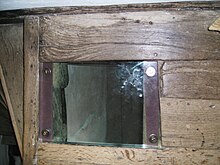Boscobel House
[1] It has been, at various times, a farmhouse, a hunting lodge, and a holiday home; but it is most famous for its role in the escape of Charles II after the Battle of Worcester in 1651.
Local government reform in 1974 brought the parish, including Boscobel House and White Ladies, into Bridgnorth District, which in 2009 was superseded by the new unitary authority of Shropshire Council.
The priory and its estate, including the farmhouse site, had been leased from the Crown by William Skeffington of Wolverhampton at the Dissolution of the Monasteries about a century earlier.
John Giffard decided to make the farmhouse more useful by building a substantial extension to the south, including a living room and bedrooms more fitted to use by a gentry family.
Thomas Blount (writing 1660), the main source for the events, portrays the naming as an after-dinner activity, and attributes it to Sir Basil Brook(e), a prominent recusant from Madeley, Shropshire, who was one of Giffard's guests at the housewarming party.
From White Ladies, Richard Penderel led Charles in an unsuccessful attempt to cross the Severn near Madeley, Shropshire.
They were forced to retrace their steps and Charles took refuge at Boscobel, where he was met by Colonel William Careless, whose brother rented land from the Giffards at Broom Hall, Brewood.
The estate and Boscobel were sold to Walter Evans, a Derbyshire industrialist, in 1812, although the Fitzherbert family retained the White Ladies Priory site.
The 16th-century farm, known as the north range, houses an exhibition of dairy equipment, focussing on the butter and cheese making that were important here in the Victorian period.
In 2011, the upper floor was opened to the public for the first time, allowing a much better appreciation of the construction and clearly showing the differing woodwork, indicating that the building was much altered even before John Giffard's additions.
The western end of the north range is now separated off to provide the entrance hall and stairs for the main house, a change apparently made by the Evans family in the 19th century.
The ground floor of John Giffard's development is occupied largely by the Parlour, much-altered but containing a good deal of Jacobean panelling.
The Victorian fireplace is surmounted by three black marble panels, each engraved to illustrate aspects of Charles' escape – two of them designed by a daughter of Walter Evans.
This contains a portrait of Jane Penderel, known as Dame Joan, the matriarch of the family to whom Charles owed so much, and a chest, dated 1642, which appears to be mainly 19th-century work.
It has been surrounded by iron railings for many decades, but an outer wooden fence was added to protect visitors from falling timber after major cracks appeared in Autumn 2010.
Three third generation descendants of the Royal Oak have been ceremonially planted nearby: Boscobel House and its grounds are generally open from Wednesday to Sunday each week in the summer (April to October).





